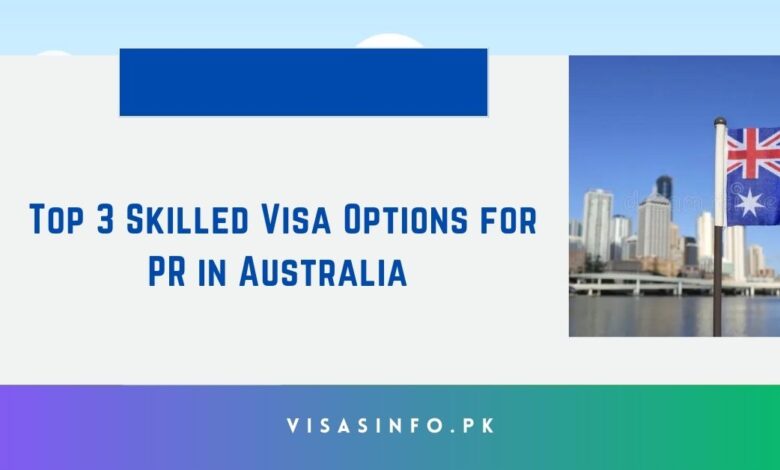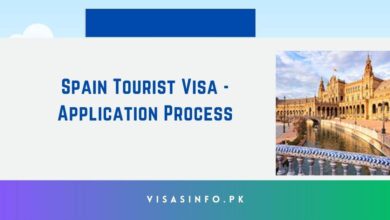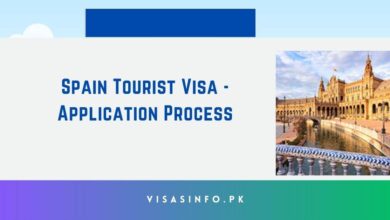Top 3 Skilled Visa Options for PR in Australia 2024

Many individuals who are interested in permanently relocating to Australia are attracted to the country’s robust economy, diverse population, and exceptional quality of life. The nation offers a variety of visa types, each with its own set of requirements and qualifications, to individuals who wish to immigrate.
This update addresses the advantages of Australia PR and the top three skilled worker visa options for permanent residency in Australia by 2024.
Benefits of Australia PR
In Australia, permanent residency and citizenship are distinct concepts. As an Australian permanent resident, you are generally permitted to work and study in the country, enroll in the national health insurance plan, and petition for permanent residency on behalf of eligible family members. Additionally, you have the option to register for Australian citizenship and travel to and from Australia, provided that you meet the necessary qualifications.
Best Australian PR Options 2024
In 2024, the following are the best Australian PR options for skilled migrants
1. Skilled Independent Visa (Subclass 189)
Subclass 189 Skilled Independent Visa is the preferred option for numerous individuals who aspire to establish permanent residence in Australia. Skilled laborers who are not sponsored by their employer, state or territory government, or family members are eligible to apply for this visa. Visa applicants must accumulate 65 points or more to qualify, as the program is based on points.
The following are the prerequisites and requirements for the Skilled Independent Visa Subclass 189:
- Initially, individuals who were under the age of 45 at the time of the invitation.
- Additionally, demonstrate a robust skills evaluation in the discipline of your choice.
- Furthermore, with an expert understanding of the English language
- In addition, achieve a minimum score of 65 points.
- Additionally, it is necessary to hold a position that aligns with the medium- and long-term Strategic Talents list.
2. Skilled Nominated Visa (Subclass 190)
In Australia, a state or territory government has the authority to designate applicants who satisfy the criteria for the points-based nominated Visa subclass 190. To qualify for the Visa, you must meet the requirements of the state or territory from which you wish to be nominated and accumulate a minimum of 65 points.
The qualifications for nominations are subject to change by state and territory. The Skilled Nominated Visa Subclass 190 necessitates the following:
- First and foremost, satisfy the prerequisites established by the state or territory government.
- Afterward, assume a position that aligns with either the medium- and long-term strategic skills list or the short-term specialized occupation list.
- Additionally, individuals under the age of 45
- You must be nominated by an Australian state or territory government in addition to achieving a minimum score of 65 points.
- Finally, obtaining a favorable skills evaluation in the selected field of employment and meeting the language competence standards in English
3. Employer Nomination Scheme (Subclass 186)
Qualified employees in Australia who are financially supported by their employers are eligible for direct admission. The subclass 186 direct entrance employer nomination program visa is a permanent resident visa. The following are the qualifying standards and requirements for the direct entry stream Employer Nomination Visa (Subclass 186):
- Most importantly, a talent that is deemed suitable and included in the roster of medium- and long-term strategic talents
- Additionally, being under the age of 45
- Furthermore, obtaining an adequate skills evaluation in the field you have selected
- Additionally, it satisfies the English language proficiency standards.
- Additionally, an active employment agreement with the employer that is sponsoring you
- Similarly, the nomination application of an Australian employer that has been approved
- Finally, a minimum of three years of full-time experience in your designated field that is both competent and pertinent
The Employer Nomination Scheme (Subclass 186) has a limitation in terms of the alternatives available to individuals who do not have a job offer from an Australian company. Each of these visas has its own eligibility requirements, advantages, and disadvantages. You may have alternatives if you are seeking a visa that is not sponsorship-required or is based on points. You must conduct a thorough assessment of your circumstances and requirements to determine the most suitable visa.
New Australia PR Pathway for 457 & 482 Visa Holders
November’s fourth report on the latest advancements in Australian immigration legislation. The primary modifications to immigration laws are the subject of this update. The migration regulations of 1994 have been significantly altered by the Australian government, and they will be implemented on November 25, 2023.
These developments should be of particular interest to holders of subclass 457 visas (temporary work qualified) and subclass 482 visas (temporary skill shortage).
The Permanent Residency Pathway for 457 and 482 Visa Holders
This adjustment is exemplified by the establishment of a pathway within the temporary residence transition streams for all 457 Visa holders and the additional 482 main Visa holders. Given this, there has been a significant change in the policy regarding permanent residency, which now considers a more diverse perspective.
Check Also: Australia Upcoming Visa Changes
Benefits of Top 3 Skilled Visa Options for PR in Australia
1. Skilled Independent Visa (Subclass 189)
- No Employer Sponsorship Required: This visa is intended for skilled workers who are not sponsored by an employer or family member and do not require nomination by a state or territory government.
- Points-Based System: Applicants are evaluated according to a points system that takes into account factors such as age, English language proficiency, work experience, and education. Earning more points can increase the likelihood of receiving an invitation.
- Permanent Residency Pathway: It offers a direct route to PR and enables you to reside and work in any location within Australia.
1. Skilled Independent Visa (Subclass 189)
- State Nomination: An Australian state or territory administration must nominate applicants. This nomination increases the applicant’s score, which may increase their likelihood of receiving an invitation.
- Increased Opportunities: The nomination of a state or territory can result in a greater number of employment opportunities in high-demand sectors or regional areas.
- Pathway to PR: Similar to Subclass 189, it provides a route to permanent residency and enables you to reside and work in any Australian state or territory following the initial period of residence in the nominating state or territory.
3. Skilled Regional (Provisional) Visa (Subclass 491)
- Regional Focus: This visa is intended for skilled workers who are willing to reside and operate in specific regional regions of Australia. Regional areas frequently offer a greater number of employment opportunities and less competition.
- State and Family Sponsorship: It may be sponsored by a state or territory government or by an eligible family member who resides in a designated regional area.
- The Subclass 191 Permanent Residency: (Skilled Regional) visa is available for applicants who have held the Subclass 491 visa for a minimum of three years and have met specific requirements. This visa is a pathway to permanent residency.
Adjustments to Occupational Lists and Health Waivers
Another essential element of these modifications is the inclusion of a health waiver for specific Visa streams, which enhances accessibility for the majority of applicants. Furthermore, the OCC employment lists for subclasses 186 and 187 have been modified to simplify the application process.
What are the consequences for visa holders and applicants?
The changes comprehensive impact should be recognized by both new applicants and those with valid visas. Qualified workers who are anxious to work in Australia are beginning to be more empathetically treated by the Australian government.
In general, the alterations to Australia’s immigration laws can be interpreted as a preliminary step toward more open and flexible immigration policies. Holders of subclass 457 and 482 visas are predominantly affected by the aforementioned modifications, which simplify the process of permanent residency and reduce the number of qualifying requirements. This represents a substantial change in the Australian immigration system.
Frequently Asked Questions:
-
In Australia, what is skill level 3?
Occupations at Skill Level 3 require a skill level that aligns with one of the following qualifications: At least two years of on-the-job training are required for AQF Certificate IV or AQF Certificate III.
-
Which Australian visa leads to permanent residency?
There are three common ways to become a permanent resident. a family-stream permanent visa. a permanent work-stream visa. business or investor-stream permanent visa.
-
How can I increase my chances of PR in Australia?
If the Australian Skilled Occupation list includes your course of interest, your chances of obtaining PR increase. Once you have completed two years of study in an authorized Australian university, college, or vocational school, you can apply for an Australian post-study work visa.



